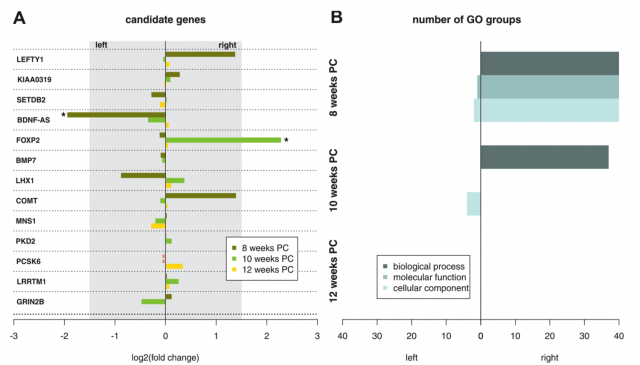About lefties and righties

Behind the symmetrical shell of humans and vertebrates lies a profound asymmetry. Our bilaterality breaks down inside our body. Not only our viscera are organized asymmetrically. Also our brain and nervous system, whose general appearance seems symmetrical, present lateralized structure and functioning. Among cognitive systems for example, language, attention, emotional processing, working memory and executive functions are asymetricaly distributed. One of the most evident manifestations of this asymetry in human beings is the clear right limb predilection for executing almost any task.
However, nowadays it is not so rare to see a lefty. Even more if you look among people who were born relieved of social pressure against being left-handed. But despite of it, the balance remains deeply lopsided: on average there is one left-hander for every ten right-handers. If you’re left-handed, you have probably wondered why you are one among many. Perhaps this trait is common in your family and therefore you attribute it to your genes. It could also be that you are the first left-hander to be remembered in your dynasty and then even more questions arise. In either case, science has been searching the answer for a while, but the truth is that at molecular level it is not clear why most humans are right-handed and right-footed, whereas there is a minority that is left-handed, ambidextrous, or mixed-handed (performing different tasks better with different limbs).
Single-gene causes of this asymmetry when handling hands and feet have been discarded recently by searches though the entire genome. On the contrary, and for the moment, several genes have been found associated with handedness. However, they explain no more than 25% of the observed limb predilection. Leaving the rest 75% to be explained by environmental factors and their interaction with the genome through epigenetic processes. Further more, global gene expression profiles comparing between hemispheres of adult brains have shown no clear differences. Only after more refined analysis of gene expression restricted to the superior temporal cortex and auditory cortex appears a slight but robust lateralization. In these cortical areas some genes involved in neuronal electrophysiology, neurotransmission and nervous system development seem lateralized (Karlebach and Francks. 2015). Even so, the implications of that in our functional asymmetry are difficult to determine yet.
This quest for molecular asymmetry as an answer for our laterality seems to be more fruitful when looking at early stages of human development. Some of the data obtained to date indicate a clearer lateralization of gene expression in various regions of the cerebral cortex of human fetuses at week 10 and 12 post conception 1. Interestingly, it has been known for decades that lateralized movements in fetus begin much earlier in the development, around week 8 post conception. What is long before the brain takes control over the spinal cord through corticospinal projections about the week15 post conception. Additionally, it seems that the asymmetry in the movement of limbs (highly right-handed) in the early fetus tends to be maintained later in children. Therefore, it might very well be that the keys of whether one is left-handed or right-handed reside not in the brain but in the spinal cord in the early stages of development.
The last is the direction in which Ocklenburg and colleges have been working recently. They explored the distribution of a wider battery of molecular cues in spinal cord segments innervating upper limbs of early fetuses. In addition to the analysis of gene expression, they measured DNA methylation, which is an epigenetic mechanism where methylation of CpG islands avoids gen expression. Moreover, they also measured expression of microRNAs, which are short single-stranded RNA able to regulate gene expression by several mechanisms 2.
What they have found is a significant lateralization of gene expression (bit more that 3% of the genes) within the two halves of the spinal cord around week 8 post conception. Further more, they also report that epigenetic marks are consistently asymmetric: many chromosomal CpG sites show differential DNA methylation. Meanwhile the location of those methylated CpG islands support up to 27% of the asymmetry in gene expression. On the same line, the expression of microRNAs is also lateralized. About 1,5% of the miRNAs that they got to measure were asymmetrically distributed and together with the DNA methylation it could explain up to 31% of the variance in gene expression. On top of that it seems that this asymmetry in gene expression and DNA methylation decays from week 8 to 12 post conception while the miRNA expression remains more or less constant.

With all, the great output of this study is the finding of the existence of molecular asymmetry concomitant to the period in which the lateralized movements begin in fetuses. Further, this study shows the lateralized expression in the spinal cord of some of the genes or pathways supposed previously important in functional lateralization (Figure 1). And of special importance seems the fact that the expression of a few miRNAs related to the TGF-B pathway (linked to left–right asymmetry during development) is shifted toward the right side of the spinal cord. However, these trends should be carefully considered as cause of the handedness. First, the low number of subjects used for this study, only 6 fetuses, could yield unrepresentative molecular asymmetries. Second, in this case, contrary to what happens in the post-mortem analyses of adult brains, the inability to check the hand preference makes impossible to know if molecular asymmetry in spinal cord explains handedness; or if it is just a reflection of the asymmetrical disposition of our viscera or other functional asymmetries.
These new findings anyway open a new dimension in which to look for the answer of why the human population is preferably right-handed. While limb preference is observed in practically all vertebrates, it is much less accused and less widespread among individuals of non-human populations (Stöckens et al. 2013). Therefore, if a molecular casuse for handdness is found, it could be not so trivial at the time of undestanding our marked cognitive differences with the rest of vertebrates. Beyond evolutive questions, finding the casuse of our handedness is an appealing quest if we want to understand why some cognitive abilities tend to be distributed differently between the cerebral hemispheres depending on whether one is left-handed or right-handed. Or why left-handedness has also been correlated with some neuropsychological pathologies.
References
- Sun, T. et al. Early Asymmetry of Gene Transcription in Embryonic Human Left and Right Cerebral Cortex. 1794–1799 (2005). ↩
- Ocklenburg, S. et al. Epigenetic regulation of lateralized fetal spinal gene expression underlies hemispheric asymmetries. 1–19 (2017). doi:10.7554/eLife.22784 ↩
1 comment
[…] Por cada 10 personas diestras hay aproximadamente 1 zurda. Pero ¿qué hace que una persona sea diestra o zurda? Daniel Moreno baja a nivel molecular para explicarlo en About lefties and righties. […]